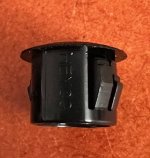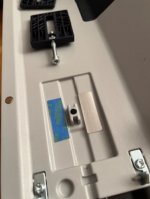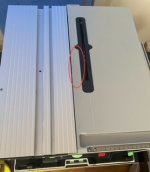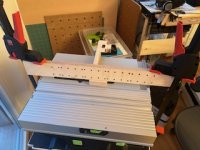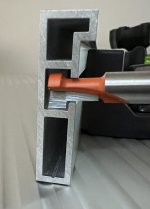sean_g said:
Just ordered the csc. I read through the posts, but was wondering if there's an updated list of must-have accessories on this to get the most out of this saw (I don't have a cabinet saw, just a track saw). I was hoping to order them around the same time.
For my money (ninja'd by [member=72072]woodferret[/member] on two of them while I was typing ;D ):
1. If you're going to be ripping thin stock, then Bow Product's
FP5 portable saw featherboard is really useful and works really well. (Note: don't get not the normal-sized featherboard; get specifically this one). Make sure you attach it as shown in the pic in
this post.
2. A
D36 anti-static hose (N.B. not the D36/32 conical hose -- you need the full diameter all the way along the hose). The bigger size improves dust extraction significantly in my experience. It's still not zero, but it much improves the clean-up afterwards. To attach it, you will need to use the connector that comes with a TS55/TS60 (you can also buy 3rd-party 3D prints of these). The main reason I suggest an anti-static hose is because the non anti-static hose tends to attract dust. If you're not overly bothered about zero-dust, then you can save money and get a cheaper non anti-static hose. (Admission: I did this and regretted it later and bought an anti-static one). And yes, you can also get a small shock from a non anti-static hose (I did -- specifically with this saw) but it is tiny and not worth worrying about.
3. For general tablesaw safety: a
Grr-ripper. Prices are crazy high, but they are very good.
sean_g said:
Is the benchdogs fence the go to fence for this? I am a beginner hobbyist - if that changes anything.
I haven't bought it and won't. Peter Millard did a video on it and I wasn't impressed:
Firstly, it seems to be using an unnecessarily-deep/thick fence extrusion (so that they can use the profiles that they use in other products, I guess), with an adapter plate that sits between Festool's own attachment and the fence. Together, these seem to significantly reduce the maximum depth of cut. Not an issue if you're cutting thin skirting or floorboards. But IMO it would have been better to design something new that sits directly onto the mitre's own attachment points.
Secondly, I dislike aluminium fences and intend -- ha! procrastination notwithstanding -- to build my own out of mdf or melamine ply. The benefit of a movable wooden fence is that you can cut into it, eliminating blowout at the back. Alu fences on the other hand don't lend themselves to being sacrificial. This is not an issue if you're cutting floorboards, but will be an issue for higher-quality cuts. (Up to now, I have add a piece of scrap, but this would even further reduce the max depth of cut with Benchdog's fence.) While I'm still procrastinating, I have at least bought what looks like the
right router bit (CMT 950.003.11 -- with 8mm shank) to create one:
View attachment 1
Thirdly, if you do cut into it, the fact that they have printed the scale directly onto the extrusion means that you can't just saw off the end and start again with a fresh zero. IMO it would have been better to have a moveable scale that you could screw / stick into position.
All credit due, though: they were quick to market with a product that fills a niche (and I think Festool should have at least included a stop block with the saw).
tl;dr: I think that there is scope for better-designed fences -- even a diy one.


